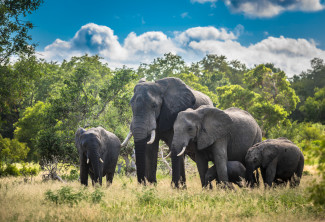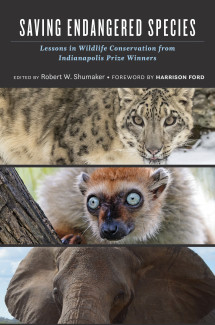
Johns Hopkins UniversityEst. 1876
America’s First Research University
Now Browsing:
Saving Endangered Species

In his now classic 1985 publication, Michael E. Soulé posed a profound question. He asked, “What is conservation biology?” At the time, his article defined this emerging new discipline. Within his answer was an elegant, philosophical assumption. He stated simply, “Diversity of organisms is good.”
Now, three and a half decades later, the state of biodiversity on our planet is sobering. About 32,000 species are threatened with extinction. The IUCN Red List notes that 25% of all mammals, more than 40% of amphibian species, almost 33% of reef-forming corals, and more than a third of all marine mammals are threatened. The U.N.’s Sustainable Goals report for 2019 states that the “average abundance of native species in most major land-based habitats has fallen by at least 20%” over the past century.
Eric W. Sanderson, a conservation ecologist with the Wildlife Conservation Society at the Bronx Zoo, and his colleagues study the impact of humans on nature. They conclude that “The influence of human beings on the planet has become so pervasive that it is hard to find adults in any country who have not seen the environment around them reduced in natural values during their lifetimes—woodlots converted to agriculture, agricultural lands converted to suburban development, suburban development converted to urban areas.” Of course, human impact is not limited to the land. Benjamin S. Halpern and his team studied 20 different marine ecosystems around the world and reached a stunning conclusion. They could find no area that was unaffected by humans, and 41% of the areas they studied were heavily impacted by humans.
Sanderson goes on to say that, “The global extent of the human footprint suggests that humans are stewards of nature, whether we like it or not. The long-term impact of human influence, positive or negative, benign or catastrophic, depends on our willingness to shoulder responsibility for our stewardship.”

The Indianapolis Prize, the world’s leading award for animal conservation, was founded to celebrate the work of exceptional stewards of nature who shoulder their responsibility with passion, integrity, and pure devotion for preserving biodiversity. Recipients of the Prize are individuals who have achieved major victories in advancing the sustainability of an animal species or group of species. The Prize is awarded by the Indianapolis Zoo on a biennial basis after applications are reviewed by a Nominating Committee that identifies 6 Finalists, and a Jury that selects the Winner. In addition to honoring great conservationists, the Prize is philosophically devoted to engaging, enlightening, and empowering the general public on the topic of advancing conservation. In this way, the Prize embraces the idea that any true and enduring conservation success must include people as a primary factor in the equation.
In the 2018 Prize cycle, which includes a gala and national lecture tour by the winner, at least 2.2 billion media impressions were earned internationally. This level of exposure fulfills another specific goal of the Prize which is to elevate conservationists as heroes and role models, especially for younger generations. Along with the Indianapolis Prize, the Jane Alexander Global Wildlife Ambassador Award was established to recognize the contributions of public figures who advocate for the conservation of biodiversity. The Award was named in honor of actor and conservationist Jane Alexander, who was also the first recipient.
To date, there have been seven winners of the Indianapolis Prize and three recipients of the Jane Alexander Global Wildlife Ambassador Award.
In Saving Endangered Species: Lessons in Wildlife Conservation from Indianapolis Prize Winners, each of these ten heroes offers their perspective on the state of wildlife conservation and the future of the natural world. This inspirational and optimistic volume begins with a foreword by Harrison Ford, and each chapter chronicles the events that shaped the conservation victories for each Prize Winner, as well as the Global Wildlife Ambassadors Jane Alexander and Sigourney Weaver. These first-person narratives delve into important and timely issues such as finding solutions to human-wildlife conflict, habitat loss, and the illegal wildlife trade.
These are the voices of the greatest conservationists of our time.
Order Saving Endangered Species: Lessons in Wildlife Conservation from Indianapolis Prize Winners – published on October 27, 2020 – at the following link: https://jhupbooks.press.jhu.edu/title/saving-endangered-species
Robert W. Shumaker is an evolutionary biologist and the president and CEO of the Indianapolis Zoo. He is the editor of Saving Endangered Species: Lessons in Wildlife Conservation from Indianapolis Prize Winners, the author of Orangutans, and the coauthor of Animal Tool Behavior: The Use and Manufacture of Tools by Animals and Primates in Question: The Smithsonian Answer Book.

Now, three and a half decades later, the state of biodiversity on our planet is sobering. About 32,000 species are threatened with extinction. The IUCN Red List notes that 25% of all mammals, more than 40% of amphibian species, almost 33% of reef-forming corals, and more than a third of all marine mammals are threatened. The U.N.’s Sustainable Goals report for 2019 states that the “average abundance of native species in most major land-based habitats has fallen by at least 20%” over the past century.
Eric W. Sanderson, a conservation ecologist with the Wildlife Conservation Society at the Bronx Zoo, and his colleagues study the impact of humans on nature. They conclude that “The influence of human beings on the planet has become so pervasive that it is hard to find adults in any country who have not seen the environment around them reduced in natural values during their lifetimes—woodlots converted to agriculture, agricultural lands converted to suburban development, suburban development converted to urban areas.” Of course, human impact is not limited to the land. Benjamin S. Halpern and his team studied 20 different marine ecosystems around the world and reached a stunning conclusion. They could find no area that was unaffected by humans, and 41% of the areas they studied were heavily impacted by humans.
Sanderson goes on to say that, “The global extent of the human footprint suggests that humans are stewards of nature, whether we like it or not. The long-term impact of human influence, positive or negative, benign or catastrophic, depends on our willingness to shoulder responsibility for our stewardship.”

The Indianapolis Prize, the world’s leading award for animal conservation, was founded to celebrate the work of exceptional stewards of nature who shoulder their responsibility with passion, integrity, and pure devotion for preserving biodiversity. Recipients of the Prize are individuals who have achieved major victories in advancing the sustainability of an animal species or group of species. The Prize is awarded by the Indianapolis Zoo on a biennial basis after applications are reviewed by a Nominating Committee that identifies 6 Finalists, and a Jury that selects the Winner. In addition to honoring great conservationists, the Prize is philosophically devoted to engaging, enlightening, and empowering the general public on the topic of advancing conservation. In this way, the Prize embraces the idea that any true and enduring conservation success must include people as a primary factor in the equation.
In the 2018 Prize cycle, which includes a gala and national lecture tour by the winner, at least 2.2 billion media impressions were earned internationally. This level of exposure fulfills another specific goal of the Prize which is to elevate conservationists as heroes and role models, especially for younger generations. Along with the Indianapolis Prize, the Jane Alexander Global Wildlife Ambassador Award was established to recognize the contributions of public figures who advocate for the conservation of biodiversity. The Award was named in honor of actor and conservationist Jane Alexander, who was also the first recipient.
To date, there have been seven winners of the Indianapolis Prize and three recipients of the Jane Alexander Global Wildlife Ambassador Award.
In Saving Endangered Species: Lessons in Wildlife Conservation from Indianapolis Prize Winners, each of these ten heroes offers their perspective on the state of wildlife conservation and the future of the natural world. This inspirational and optimistic volume begins with a foreword by Harrison Ford, and each chapter chronicles the events that shaped the conservation victories for each Prize Winner, as well as the Global Wildlife Ambassadors Jane Alexander and Sigourney Weaver. These first-person narratives delve into important and timely issues such as finding solutions to human-wildlife conflict, habitat loss, and the illegal wildlife trade.
These are the voices of the greatest conservationists of our time.
Order Saving Endangered Species: Lessons in Wildlife Conservation from Indianapolis Prize Winners – published on October 27, 2020 – at the following link: https://jhupbooks.press.jhu.edu/title/saving-endangered-species
Robert W. Shumaker is an evolutionary biologist and the president and CEO of the Indianapolis Zoo. He is the editor of Saving Endangered Species: Lessons in Wildlife Conservation from Indianapolis Prize Winners, the author of Orangutans, and the coauthor of Animal Tool Behavior: The Use and Manufacture of Tools by Animals and Primates in Question: The Smithsonian Answer Book.

Login to View & Leave Comments
Login to View & Leave Comments


